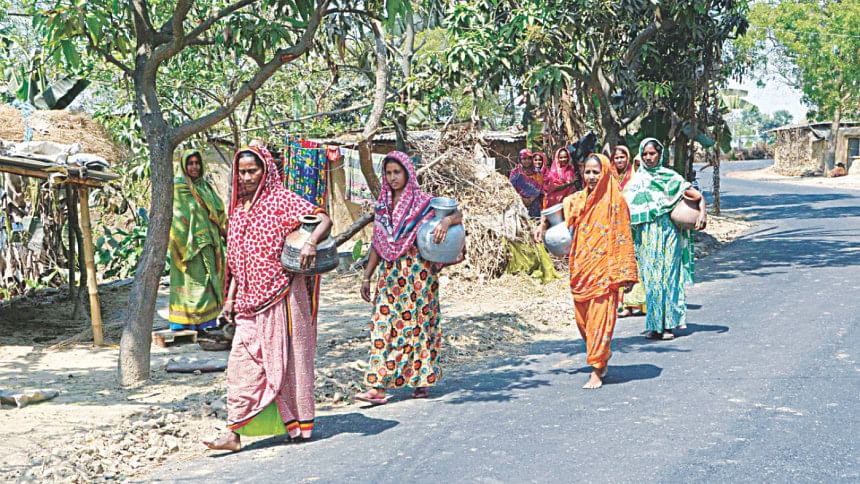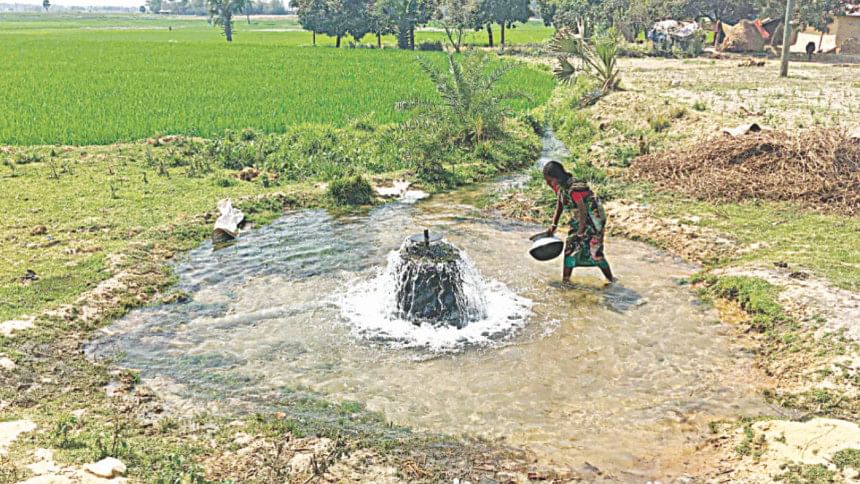The thirsty land

When Kajol Rekha's primary-school-aged son starts playing with water his mother gets annoyed. It's a source of tension in the household, in Sreerampur village in Rajshahi's Godagari upazila. Water has become a precious resource. Across swathes of the Barind Tract in the country's north, from Rajshahi and Chapainawabganj to Naogaon, areas that until the 1980s suffered regular floods now have the opposite problem: water scarcity.
“In summer our village runs short of water,” says Rekha, “I have to sweat to collect it. Why should I let my son waste it?”
For years the nearest tube well has been dry. Rekha usually crosses the Rajabari to Kundoli Road not far from her home to fill water pots. But sometimes the supply line there is out of order. Then she walks over a kilometre to a neighbouring village; but sometimes the villagers there won't let her take their water. Then she has to walk even further.
“Last week we had two days when we couldn't bathe,” Rekha says. “Sometimes we don't have drinking water at hand.”
The United Nations reports that more than 663 million people globally live without safe water supplies close to home. For many people, spending hours queuing for water, trekking to distant water sources and coping with the effects of contaminated supplies is usual.
Prominent hydrologist from Rajshahi University, Professor Chowdhury Sarwar Jahan has been speaking about the potential for the government to declare some parts of the Barind region as 'water stressed' since at least 2016. “It's not a reason to panic,” he says, “but it is a reality deserving government attention and countermeasures.”
As a member of the government's groundwater taskforce, the professor is responsible for researching groundwater conditions and droughts. “The problem is exacerbated by climate change,” he says. “It becomes acute due to excessive extraction.”
Once, the region could expect around 2,500 millimetres of annual rainfall; in the five years up to 2017 annual rainfall did not exceed 1,400 millimetres. “Rainfall has decreased so much that irrigation is required even during the monsoon, for Aman paddy,” says Professor Sarwar.
Changing water usage habits are also to blame. “Three decades ago Barind farmers harvested one crop per year,” notes the executive director of the Barind Multipurpose Development Agency, Abdur Rashid. “Back then, groundwater was at most 70 feet below ground. Now farmers grow three crops annually, a production increase made possible by the installation of large numbers of wells since the 1990s. The issue of food security couldn't be ignored.”
From the turn of this century farmers and businesspeople began installing deep tube wells on their own, alongside government projects. In recognition of falling groundwater levels caused by so much extraction, the agency in 2012 prohibited the installation of more wells and began to prioritise surface water for irrigation.
Yet, based on a recent report by the Bangladesh Agriculture Development Corporation into tube wells in the 16 northern districts, one official estimates that around 75 percent of the current annual total of 13,710 million cubic metres of groundwater extracted is done by unregulated private wells, with government-approved wells attributable for the rest.
“Groundwater levels are still in drastic decline,” says Rashid.

The uppermost groundwater level recorded in Nachol upazila in February this year was 107 feet below the surface, which represents a fall of over 28 feet since 2005, when the area's groundwater was to be found at 78.8 feet underground.
“On hot summer days levels fall further still,” Rashid says. “The level in some areas might be as deep as 130 feet below the surface, the result of five months of irrigation combined with year-round water use at brick kilns, power plants and for fish cultivation.”
The scarcity hasn't gone unnoticed by Rajshahi's farmers. “Irrigation costs have doubled,” says Soyebur Rahman, a farmer from Idolpur village in Godagari. “Deep tube wells can't extract water like they used to. The amount of water a well could draw in half-an-hour now takes more than one hour to draw.”
“For water scarcity 50 of my 200 bighas of land remained uncultivated last year,” says another farmer, Abdur Rashid from Jumarpara village in Tanore upazila.
The problem has encouraged many farmers to move away from rice cultivation in favour of less irrigation-reliant crops like wheat, mustard and potatoes. Other farmers are transforming cropland into mango and guava orchards. Still others have been forced to leave their homes to pursue employment elsewhere.

 For all latest news, follow The Daily Star's Google News channel.
For all latest news, follow The Daily Star's Google News channel. 






Comments